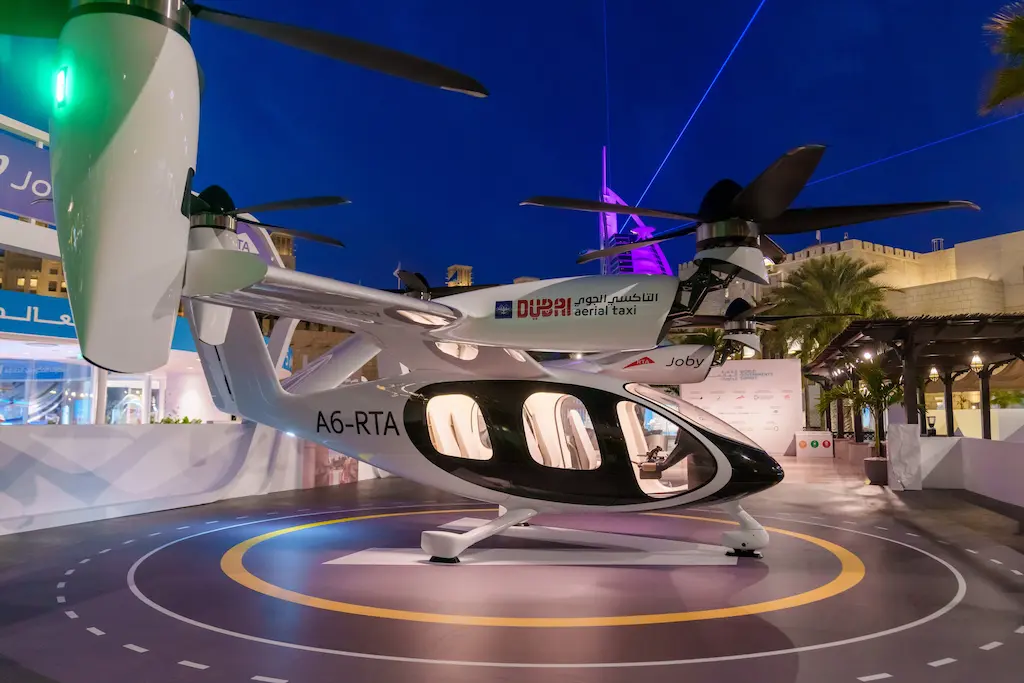
Dubai takes flight with its first fleet of air taxis (source-X@jobyaviation)
Dubai’s Leap into the Future, The Air Taxi Era Begins
Dubai Launches Air Taxis – Dubai’s recent unveiling of its air taxi initiative has captivated the global audience. Partnering with Joby Aviation and investing heavily in vertical takeoff and landing (VTOL) infrastructure, the emirate aims to revolutionize city commutes by 2026. These electric aircraft are:
- Capable of speeds up to 300 km/h
- Have low noise emissions
- Offer a range of about 160 km per charge
- Operate autonomously or with minimal crew intervention
With strategically placed “vertiports,” Dubai plans to integrate air taxis into existing metro hubs and tourist zones. The goal is clear: reduce congestion, elevate travel experience, and claim first-mover status in the urban aviation game.
Dubai’s success isn’t just about tech, it’s about vision. Its policy ecosystem, investor enthusiasm, and infrastructure agility have come together to create a launchpad for airborne mobility. The global impact? A new benchmark for smart city planning.
India’s Opportunity, Flying Cars or Missed Connections?
India, with its sprawling urban chaos, overloaded roads, and metro traffic jams, stands to gain immensely from air taxi adoption. But despite domestic advancements in EVs and drone technology, India is yet to formulate a concrete roadmap for VTOL aircraft integration.
Here’s what’s in India’s favor:
- A vibrant startup ecosystem with players like The ePlane Company and Vinata AeroMobility working on prototypes
- High demand in Tier-1 and Tier-2 cities for alternative mobility
- Government support for e-mobility via PLI schemes and Smart City initiatives
- Existing drone regulations that can evolve to support passenger flights
But hurdles remain:
- No dedicated VTOL policy framework
- Airspace congestion near urban hubs
- Safety and public trust concerns
- Infrastructure gaps, India lacks “vertiports” and EV-compatible aviation zones
What India needs is a bold vision, akin to UPI in fintech or Aadhaar in digital governance. With bureaucratic acceleration and PPP (Public-Private Partnership) models, urban skyways could become as real as metro rails.
India’s Flight Plan – Blueprints, Backers & Big Bets
To make air taxis a reality, India must blend innovation with regulation. A three-tiered strategy could be the answer:
1. Build the Ecosystem
- Encourage VTOL R&D under ‘Make in India’
- Provide incentives for EV aviation startups
- Collaborate with international air mobility firms for tech transfer
2. Upgrade Infrastructure
- Designate Urban Air Mobility Zones (UAMZ)
- Build multi-modal transport hubs with vertiports
- Ensure EV charging compatibility in aviation-grade formats
3. Establish Trust & Governance
- Introduce a pilot sandbox for urban air mobility trials
- Develop passenger safety protocols and insurance models
- Integrate DGCA, urban bodies, and Ministry of Civil Aviation into a single command centre
India doesn’t lack potential, it lacks convergence. With foresight and decisive action, air taxis could be the next big leap for India’s smart cities and EV ecosystem
Stay updated with the latest news on Rapido Updates. Keep yourself updated with The World, India News, Entertainment, Market, Automobile, Gadgets, Sports, and many more